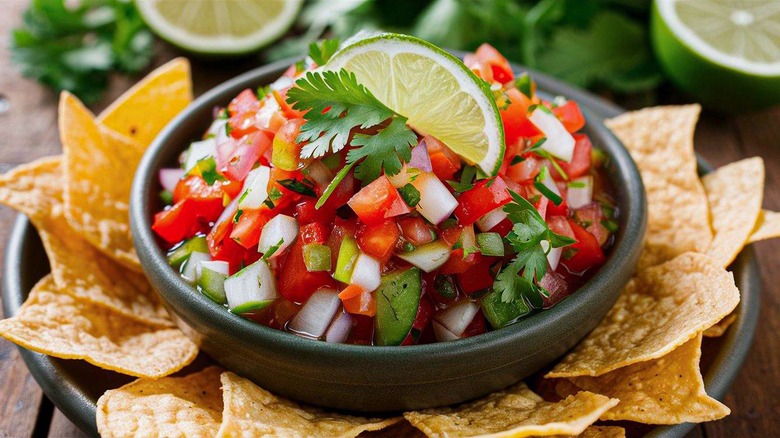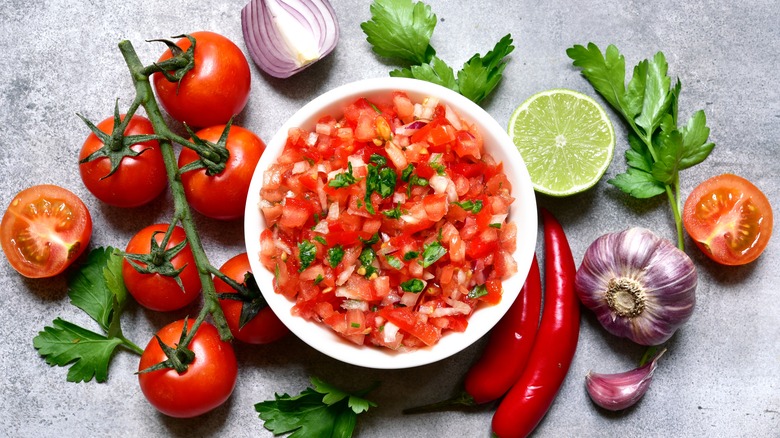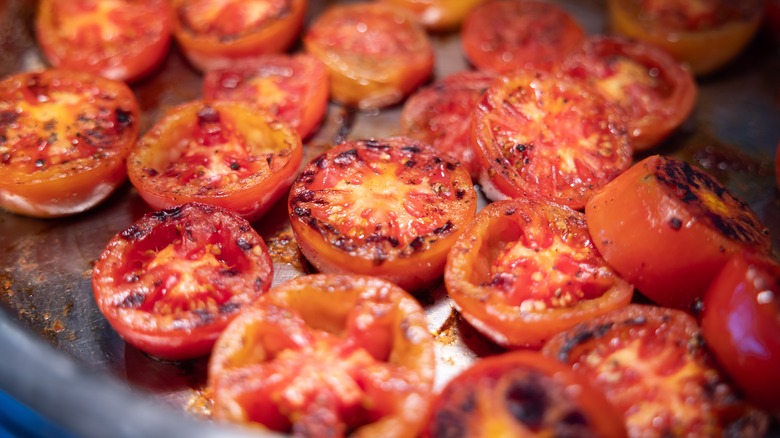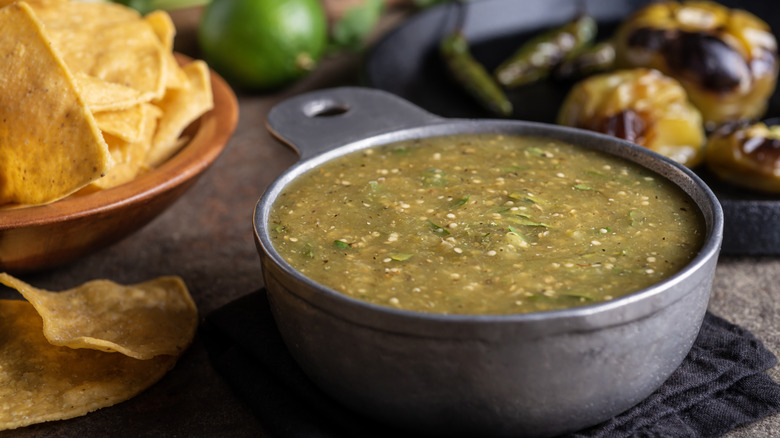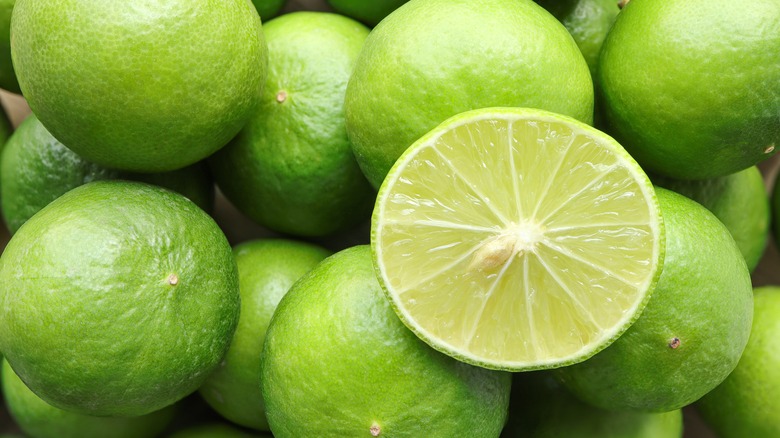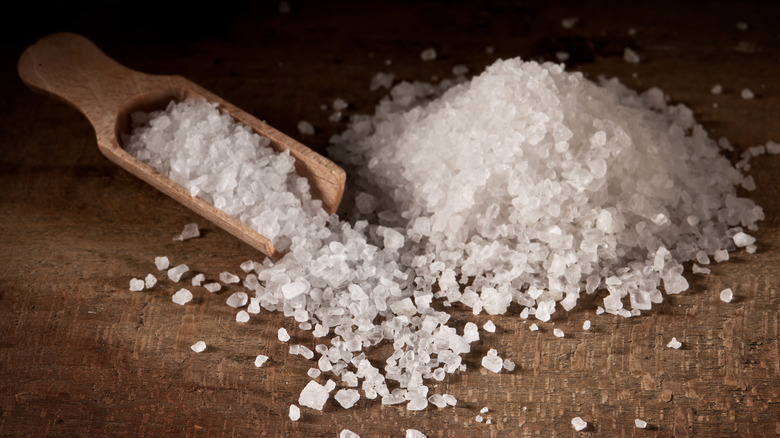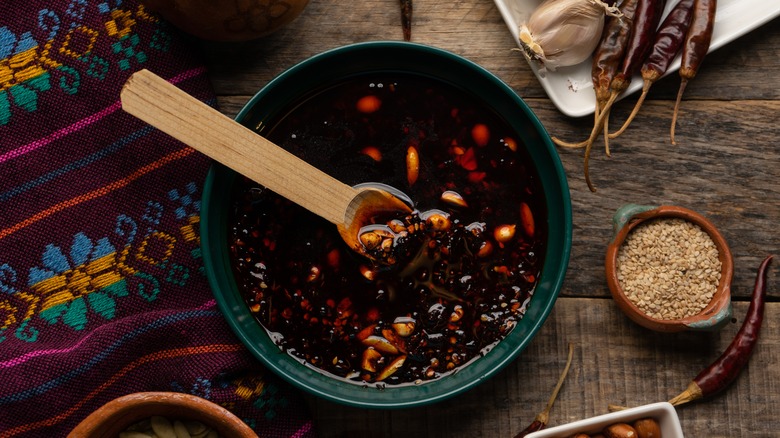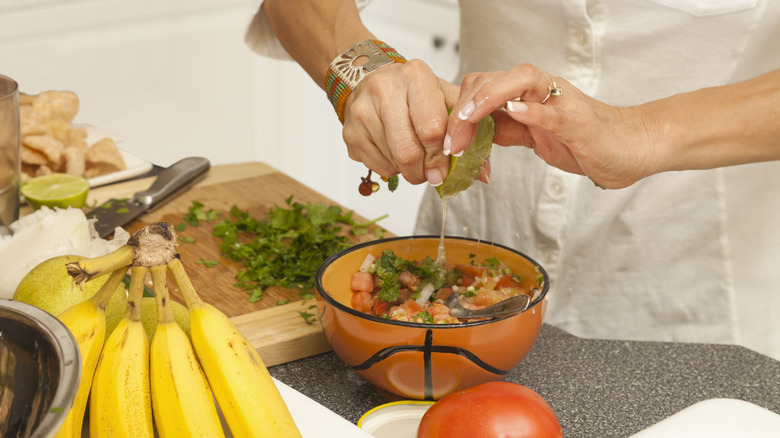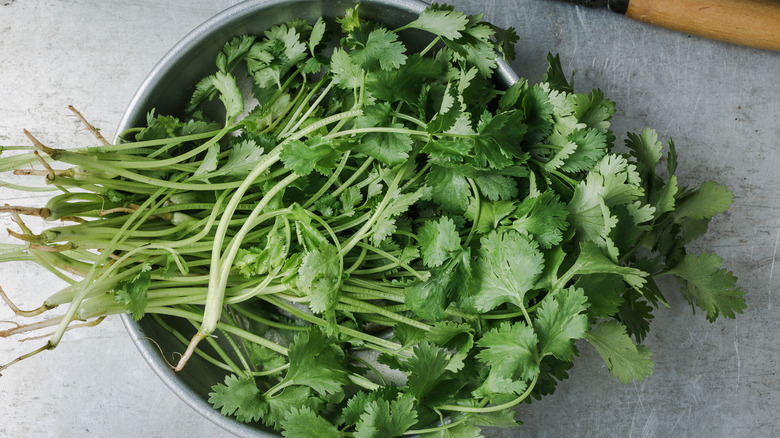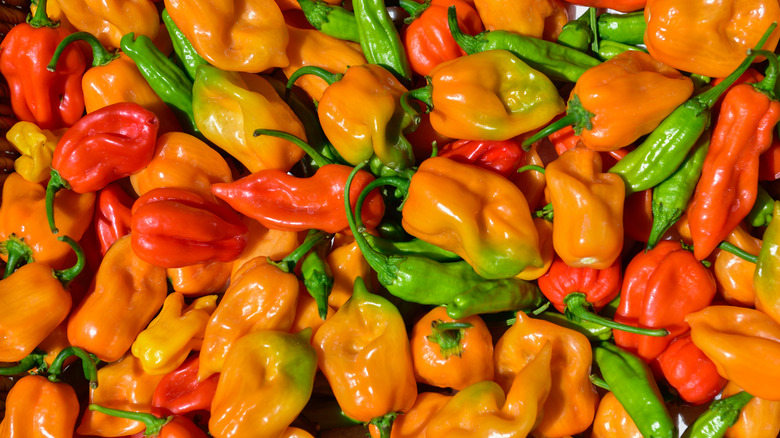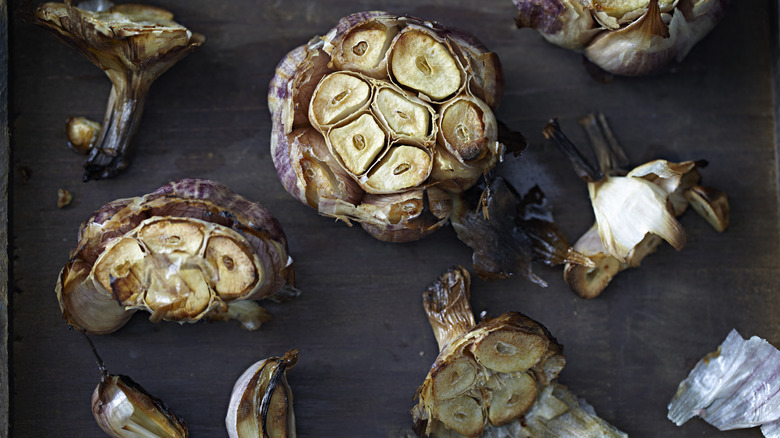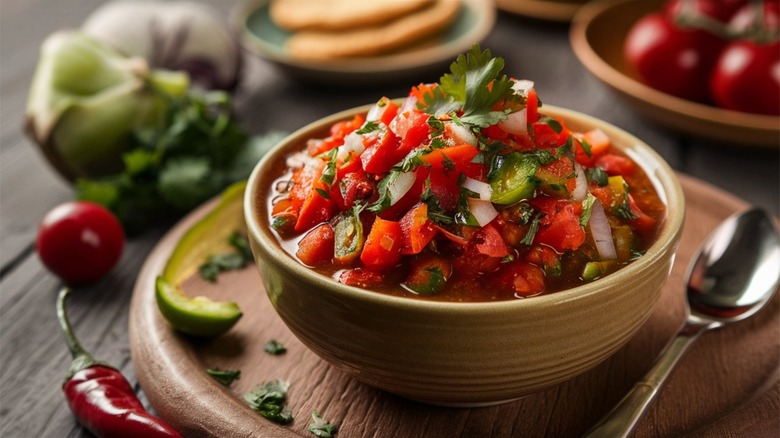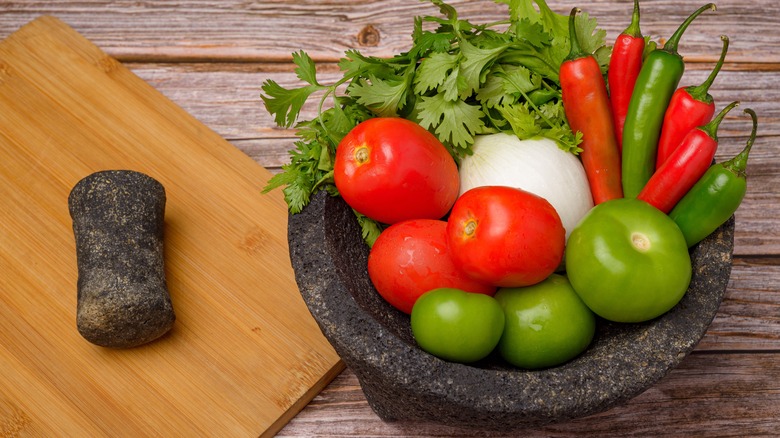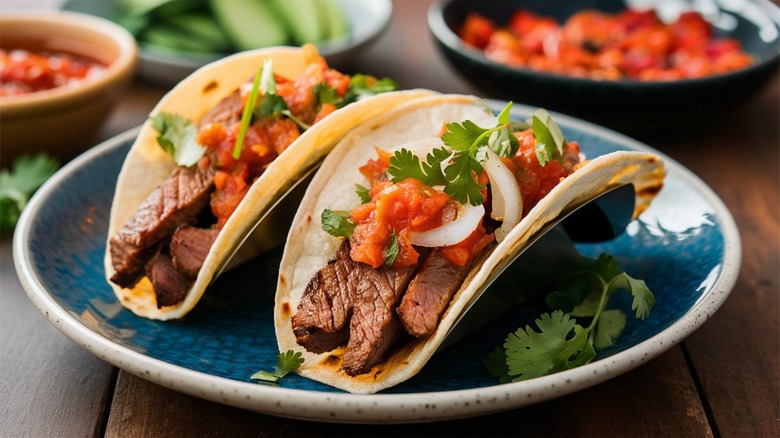Why Salsa Always Tastes Better At A Restaurant
If you love Mexican food, you probably have a favorite restaurant salsa. Try as you might, you just can't recreate it at home. Your attempts come out watery, tasteless, over-seasoned, or just not quite right. So, why is it that salsa always tastes better at a restaurant?
Now, before we catch any flack, we know that your abuela probably makes the perfect homemade salsa, and we're not denying that. It's more that the average home cook can't recreate a good restaurant-quality salsa. And, there certainly isn't anything as good you can just buy from a regular grocery store. On a similar note, there are admittedly some restaurant salsas that don't cut it, but we're focusing on the great ones.
To get to the truth of the matter, we spoke with two chefs from Mexican restaurants who have experience making salsa in-house: Antonio Tevillo, the Chef de Cuisine at Tamayo in Denver and Alex Tellez, the Chef at Sor Ynéz in Philadelphia They revealed some tips and tricks about making restaurant-quality offerings that might be where you're tripping up with your homemade versions. Not only will this answer the age-old question of why salsa tastes better at the restaurant, but you'll also get some ideas as to how to improve your own.
Restaurant salsa is made using fresh, high-quality ingredients
When you're making your salsa at home, you might pick up whatever tomatoes you can find at the store and use the pickled jalapeños that have been languishing at the back of your fridge for months. Restaurants, on the other hand, make salsa with high-quality ingredients. This attention to sourcing can make all the difference in the finished recipe.
According to chef Antonio Tevillo, "Fresh, high-quality ingredients are essential for making a great salsa." He explains that the vibrant, intense flavors of great veggies are what make a salsa stand out. "Using ripe tomatoes, fresh chilies, and just-picked herbs ensures that each bite is bursting with flavor," he adds. "Quality ingredients bring out the natural flavors, making the salsa more authentic and enjoyable."
"Fresh produce is the most flavorful and the salsa will taste bland without it," agrees chef Alex Tellez. He maintains that choosing quality ingredients is key to good salsa. So, rather than using watery grocery store tomatoes, hit up your local farmers market for quality heirloom varieties. Or, look out for any of these chef-approved tomato varieties for making salsa. If you have one in your area, head to a Mexican market for quality chilies or ingredients like tomatillos. You'll often find high-quality fresh herbs in these kinds of stores too.
Chefs may use techniques such as charring to make the most out of ingredients
Yes, using the freshest ingredients possible for homemade salsa is ideal, but chef Alex Tellez knows that it's not always possible. Even at restaurants, there may be times of the year when produce isn't at its finest. Or, a delivery might come in with watery tomatoes and chefs need to pivot. "If access to fresh, seasonal produce is challenging, you can char the ingredients to help bring out their flavor profiles," Tellez recommends.
Charring doesn't have to be limited to improving poor quality ingredients. In fact, it's a method restaurants often use for certain salsa types. "Charred salsas use ingredients that have been charred or roasted and blended together, which is great to complement meats like carne asada," says Tellez. Roasting and charring generally intensify the flavors of ingredients. The resulting salsa tastes rich and smoky rather than fresh and light.
If this sounds like your favorite restaurant salsa, this gives you a starting point to recreate it. You can roast or broil veggies to make an intense salsa. This not only concentrates the flavors, making the ingredients richer and sweeter, but the Maillard reaction also plays a role. As browning occurs, it brings out extra flavor compounds — which explains why charred, seared, and roasted foods are so delicious.
Chefs have a wide repertoire of salsas
One of the reasons why restaurant salsa is so good is that chefs at Mexican restaurants know how to make a wide range of varieties. When you think of this popular condiment, you might picture a classic tomato salsa, but there are so many more options. Salsa simply means sauce in Spanish, and there are plenty of amazing salsa recipes you need to try. Some traditional Mexican salsas are quite different from what you might imagine. For instance, they might contain avocado and tomatillos or they could feature red onions as the main ingredient.
"There are many types of salsas, each bringing something unique to the table," says chef Antonio Tevillo. "Some of the basics include Salsa Roja, which is made with ripe tomatoes, onions, garlic, and chilies. Then there's Salsa Verde, typically made with tomatillos and green chilies like jalapeños or serranos." Try making a fresh tomatillo salsa verde recipe to experiment with a different variety.
There are cooked salsas, such as the charred one mentioned above, and there are also boiled salsas. According to Alex Tellez, these are made by boiling and then blending ingredients. He explains, "This type of salsa is typically creamier due to the emulsification." Meanwhile, he also describes raw salsas, "like pico de gallo, where all the ingredients are left raw and mixed together."
Lime and other acidic ingredients play a starring role in some restaurant salsas
The reason your homemade salsa isn't reaching the heights of your restaurant favorites could be because you aren't paying enough attention to acidic ingredients. You might not be using as much lime or vinegar as chefs do in restaurants. In turn, you may not have the correct balance of ingredients.
Chef Antonio Tevillo tends to use more lime or other acidic ingredients, such as vinegar, than people might at home. "Acidity is crucial in balancing the flavors and adding brightness to the salsa," he says. "Many home cooks might not realize how much acidity can elevate a salsa. It cuts through the richness of other ingredients and enhances the overall flavor, making the salsa more refreshing and lively."
However, not every chef believes that lime or vinegar are necessary in salsa, with some exceptions. "In Mexico, the only salsas we would add lime to are salsa verde or guacamole," says chef Alex Tellez. He thinks that some recipes began using limes or acidic ingredients to help make them more shelf-stable. At Sor Ynéz, he doesn't add acidic components to the salsa.
So, your restaurant fave may or may not contain lime, depending on the chef. Salsa needs acidity, but the tomatoes in a red salsa are already acidic. If you're looking to improve your homemade version, you might want to experiment with different levels of acidity to find the right balance.
There may be more salt in restaurant salsa than homemade or store-bought varieties
If your homemade salsa just isn't matching up to the restaurant-quality ones you love, it might be because it contains less salt. Although some people try to limit the amount they use at home, salt plays an important role in the kitchen. It elevates flavors by intensifying the taste of other ingredients, like tomatoes and onions.
In a commercial kitchen, chefs carefully balance salt and know just how much to add to make it taste great. "Salt is a key ingredient in salsa," Antonio Tevillo tells us. "It enhances the natural flavors and brings everything together." He explains that the perfect amount of salt highlights the sweetness of the tomatoes, the kick of the chilies, and the brightness of the herbs. "It's important not to overdo it, though — just enough to bring out the best in each ingredient," he adds.
Alex Tellez agrees that salt is important. "One secret is that people tend to be scared of salt," he says. "The key is to use kosher salt, which isn't as processed, so it doesn't have a harsh bite like table salt does," he adds.
Some restaurant salsas are made with oil
You'll find oil in some restaurant salsas and this might be different from the ones you've been making at home or the store-bought options you've tried. Although oil isn't a necessary ingredient in all salsas, it can make a huge difference in certain varieties. Without added oil, they just won't pack the same punch.
"We don't use oil or fats in our salsa unless it's a salsa macha," explains Sor Ynéz chef Alex Tellez. "Salsa macha is an oil-based salsa made with chile de arbol and is known for its spice level." He goes on to note that its flavor is affected by the oil you use, so the one you opt for matters. "For a salsa macha, we use avocado oil," he specifies.
"I typically don't use oil or fats in traditional salsas, as they can alter the purity of the flavors," Antonio Tevillo of Tamayo tells us. "However, in some roasted or cooked salsas, a little oil can help to mellow out the heat and bring a smooth texture." He notes that the richness of oil balances out the acidity in certain recipes. So, you might not need oil in your salsa, but you shouldn't shy away from using it where it's called for.
Chefs know how to balance flavors in salsa
There are plenty of mistakes everyone makes with homemade salsa that make it inferior to the good restaurant stuff. One of the most common and hardest to pin down is failing to balance the flavors. Creating equilibrium is something chefs are trained in but home cooks don't always think about. It's often learned through trial and error since various factors can impact it. You can't just follow a recipe and expect the same results or perfect balance every time.
"Balancing flavors in salsa is an art," remarks chef Antonio Tevillo. "You need to consider the sweetness of the tomatoes, the heat from the chilies, the acidity from the lime, and the freshness of the herbs." The thing is that all these elements can vary. Some tomatoes are sweeter than others and some limes are more acidic. Therefore, it requires tweaking every time — and someone who knows what they're doing. Tevillo tastes as he goes, making adjustments as needed "Sometimes, adding a touch of sugar or a little extra lime juice can make all the difference," he explains.
Chef Alex Tellez also thinks about balance. "We use kosher salt to help bring the flavors together," he says. Balance includes considering ingredient ratios, so that one doesn't overpower the rest. As an example, Tellez shares: "A mistake I've seen home chefs make is using too many peppers in their salsa. One trick is to use peppers as 20% of the salsa."
You'll usually find fresh herbs in restaurant salsa
If you've been using that shaker of dried cilantro from your spice rack, you need to stop. Chefs at Mexican restaurants almost always use fresh herbs in their salsa. Dried counterparts can be useful in some dishes but don't taste exactly the same and can't be used interchangeably.
Chef Antonio Tevillo always prefers fresh herbs over dried ones. "Fresh herbs bring a vibrant, aromatic quality to the salsa that dried herbs simply can't match," he says. "Cilantro, in particular, should always be fresh." And, cilantro is a common ingredient used in many salsas, so it's one you should put on your grocery list if you intend on making it from scratch.
Alex Tellez remarks, "It's important to always use fresh herbs, if possible." He explains that dried herbs are more potent, ounce for ounce, meaning you can't just switch fresh herbs for dried in a recipe and expect the same results. According to Tellez, fresh herbs are also more easily distributed throughout a salsa.
There's a considered use of chile peppers in restaurant salsa
When making salsa at home, you might be tempted to use whatever chilies you can get your hands on at the supermarket. Similarly, many commercial producers will use anything that's cheap and gives their product a kick. A good restaurant, however, will have a much more careful and considered use of hot peppers.
"I use a variety of chilies depending on the salsa, from jalapeños and serranos to habaneros and guajillos," Antonio Tevillo tells us. It's not just the type that matters to him, but where they come from. "The source is very important, as chilies grown in the right conditions have a more consistent flavor and heat level," he says. Tevillo prefers to source his chilies from regions like Oaxaca or Puebla, which are known for their quality. "The terroir of the chilies can affect the salsa just as much as the terroir affects wine," he remarks.
Alex Tellez is also picky about his chile peppers. "We mainly use serrano peppers in our salsas, but if you prefer a milder spice, use jalapeños," he says. He suggests shopping for hot peppers at Mexican grocery stores if you can't get any that are grown in your region. These will usually come directly from Mexico, where peppers are in season all year.
Chefs sometimes have tricks to minimize the bite of raw garlic or onion
Is the problem in your salsa that there's too much of a bite from the raw garlic or onion? This can be a common complaint, but there are a few chef-approved tips to mellow it out. That way, you can enjoy raw salsas — or ones with raw components — without suffering major garlic breath.
"One trick is to soak the chopped onions in cold water for a few minutes before adding them to the salsa," says chef Antonio Tevillo. "This removes some of the harshness and makes the onion flavor more subtle." He also has a suggestion for garlic: "roasting it before adding it to the salsa can mellow out the sharpness and bring out a sweeter, more complex flavor."
You could also adjust the type of salsa you make if you don't like overly pungent garlic or onions. "If using raw garlic or onion is too harsh, you can grill or oven-roast the salsa," suggests chef Alex Tellez. Ultimately, heat will tame the intensity of these ingredients, so a roasted or charred salsa might be in your future.
Restaurant salsa is allowed to rest before serving
If you're suffering from underwhelming salsa, you might be skipping an important step: resting. Many people finish making salsa and serve it right away, but this isn't how it's done at most restaurants. There's some time between making it and serving it, and this pause can affect the flavors for the better.
"One secret is letting the salsa rest for a while before serving," says Antonio Tevillo. "This allows the flavors to meld together and develop a deeper, more complex taste." As the salsa rests, the flavor compounds mix and mingle, so it tastes better with a more even blend of ingredients across every bite.
All you need to do to achieve this is make the salsa ahead of time. If you're in a pinch, make it before you start on any of the other components of your meal. But, if you have the time, you could make it a few hours or even a day or two in advance.
Professional kitchens may have equipment you don't have access to at home
They say a bad worker blames their tools, but a lack of the kind of kitchen equipment you'd find in a commercial restaurant might play a part in how your salsa ends up. Using the tools you have at home to work your salsa won't give you the same results as having the proper gear. One example is the equipment used to turn salsa into a paste or puree.
"Using a molcajete (a traditional Mexican mortar and pestle) to grind the ingredients can add a special touch that enhances the overall flavor and texture," Antonio Tevillo tells us. However, most people making it at home are going to use a blender or food processor. Using a molcajete gives you more control over how chunky or smooth your salsa turns out. It's harder to achieve that level of finesse with a food processor. You also release more flavor compounds using a mortar and pestle, so the finished result will be tastier overall.
Chefs make sure the salsa is balanced against the dish it's being served with
We've mentioned balance, but a great chef takes things even further. Rather than just making sure the salsa is balanced in itself, they'll also check how it pairs with whatever it's being served with. This takes a level of finesse that most home cooks just don't have.
Chef Antonio Tevillo tells us you should "taste the salsa with the dish it will accompany." He adds, "Sometimes a salsa might taste perfect on its own, but when paired with food, it might need a little more salt or lime juice." If you want the restaurant-quality salsa of your dreams, you have to go beyond basic balance and look at the whole picture.
Consider what you're serving your salsa with and adjust as necessary. For instance, if you're eating it with salted tortilla chips, you can probably go light on the salt. Ideally, taste all the components together before you serve the dish and then make changes to the salsa if needed.
